No matter what you're mixing, impeller selection is critical. It plays a role in mixer specifications and your end product. Disperser blades, propellers, hydrofoils, and other common impeller designs make for a confusing choice.
Can this disperser blade give me the off-bottom suspension I need? How is a hydrofoil different from a propeller? What is a hydrofoil? Before you buy an impeller, you need to consider a few aspects of your product and process:
Process and Product Considerations
Impeller selection is often based on finding a balance between flow pattern, shear, and pumping capacity that suits your specific application. How do you know what balance you need to strike between the two? It depends on the desired outcome, ingredient properties, and vessel geometry among other factors.
Ingredient Properties
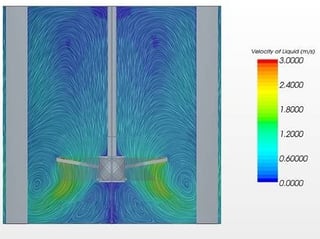
Are the liquids used in your application miscible or immiscible? How viscous are the liquids? Do the solids you are mixing in have a tendency to agglomerate? Processes combining miscible liquids don't often require high-shear impellers because the mixing is driven primarily by the flow of the liquid. In this case, it is better to go with a radial or axial flow impeller, depending on your process requirements. Impellers are specifically designed to be more efficient at certain viscosities.
Desired Outcome
If the end goal is simply to mix a soluble solid and a liquid, a propeller or hydrofoil will get the job done. If the end-goal is to suspend an insoluble material into a liquid, however, you will need a high-shear impeller. If you want to disperse a gas throughout the mixture, you will need a dispersion blade or other high-shear impeller.
Vessel Geometry
Most mixing tanks are cylindrical in design with the agitator coming down from the top of the tank with the impeller located near the bottom of the tank. Impeller diameters are typically configured for the specific application, but theoretically speaking, the impeller diameter should be about the same as the distance between the bottom of the impeller and the bottom of the tank.
Baffles also play a big role in tank geometry. Will the tank have baffles? Will the tank have 3 or 4 baffles? Baffles can drastically increase the efficiency and effectiveness of your mixer because they help create an axial flow pattern in the tank. Avoiding solid body rotation is an important part of impeller selection and tank geometry, and baffles can help with this.
Different Types of Impellers
Impellers come in all different shapes and sizes. They have different optimal speeds of operation, pumping capacity, and shear just to name a few attributes among many. It is important to get the right impeller for your application, so that you achieve the best results and the greatest efficiency possible.
This brief introduction to different impeller classes will help you get started down the right path to selecting the best impeller that will propel your project to success.
Axial Flow Impellers
Impellers in this class create an axial flow pattern. This is called an axial flow pattern because the liquids flows parallel to the axis around which the impeller rotates. Axial flow impellers typically pump the liquid in the tank downward using angled blades. This downward push on the liquids allows content in the top and the bottom of the tank to mix.
These impellers are most commonly used for heat transfer, solids incorporation, solids suspension, and blending among other applications. Within the axial flow impeller class, propellers and pitched blade turbines are the most common for low to medium viscosity applications.
Radial Flow Impellers
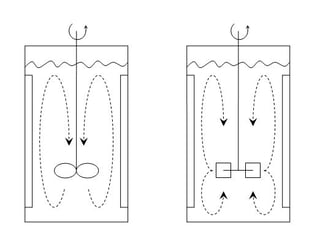
Radial flow impellers pump the liquid out toward the side of the tank along the radius of the impeller. As opposed to axial impellers, radial impellers don't have angled blades as this would force the liquid downward.
Instead of creating the two mixing loops of an axial flow pattern, radial impellers create four loops that divide the tank into quadrants.
Radial flow patterns are most useful for gas-liquid and liquid-liquid dispersion, but they can be used for other processes. Radial impellers can leave solid particles on the bottom of the tank if their is not enough power to create adequate off-bottom suspension.
But, what about the impellers themselves? How do I know if an impeller creates a radial flow? Generally speaking, there are two characteristics of radial impellers: open/disk and curved blade/flat blade.
- Disk - Impellers with disks are used to create a more uniform radial flow pattern and when you need to prevent gases from rising along the shaft of the mixer.
- Open - The right impeller below has a completely open space between each blade that allows for easy CIP, but provides less power than disk impellers.
- Curved - Curved (a.k.a. backswept) blades like those on the right impeller allow materials caught on the blade to come off the blade as it rotates.
- Flat - The flat blades on the left impeller provide more power and pumping capacity than the curved blades because of the angle at which the liquid is pushed off the blade.
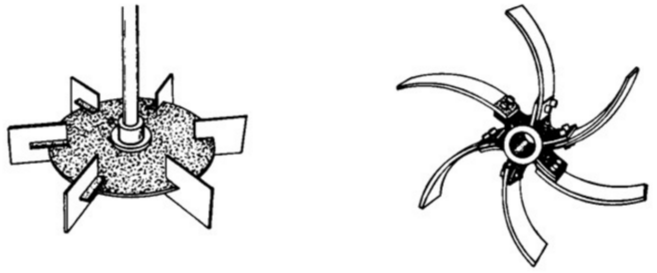
Hydrofoil Impellers
Many of the recent advances in impeller technology have come in this category. Hydrofoils are designed to pair an axial flow pattern with low shear.
Hydrofoils are also distinguished by the twisting blade that has a similar look to a pitched-blade turbine. The twisting blade creates more consistency in how quickly fluids are moving when they are pushed by the blades.
Because the blades push fluids at a constant velocity across the blade, hydrofoils maximize pumping capacity while reducing the impeller's power number. Thus, hydrofoil impellers are a great option if you are restricted by the amount of power you can get to your mixer.
High Shear Impellers
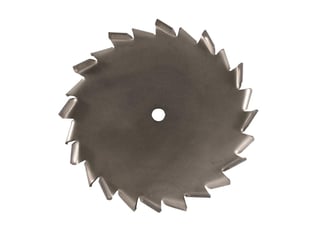
Maybe you didn't know it at the time, but chances are that you've used a high-shear blade before. Think of a tablesaw blade or a circular saw blade when you think of a high shear impeller; that really is what they look like albeit with a few modifications to make them more efficient for solid-liquid dispersion and other other applications.
This impeller is one common design for disperser blades. It is designed to maximize shear, which is useful for breaking up solids that have agglomerated in your mixture.
Another high-shear impeller design is the bar turbine.
Bar turbine impeller design has lower shear
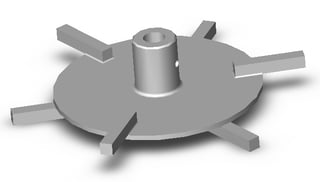
than other impellers designed for that purpose, but it still provides a useful amount of shear.
It is a disk impeller so that more 'bars' can be included with the impeller.
High shear impellers have very little, if any, pumping capacity and need to operate at high speeds to be effective. It is also fairly common to combine high shear and axial flow impellers to get the best of both worlds: high flow rates and high shear.



